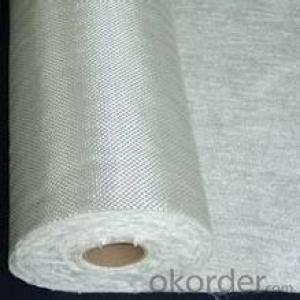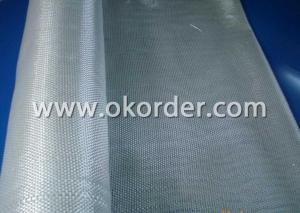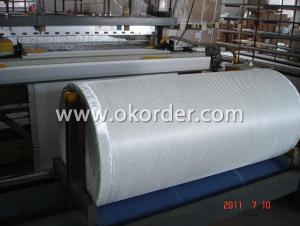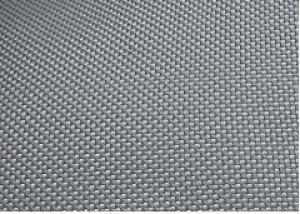High Silica Fiberglass Fabrics with Good Quality
- Loading Port:
- China Main Port
- Payment Terms:
- TT OR LC
- Min Order Qty:
- -
- Supply Capability:
- -
OKorder Service Pledge
Quality Product, Order Online Tracking, Timely Delivery
OKorder Financial Service
Credit Rating, Credit Services, Credit Purchasing
You Might Also Like
Quick Details
| Place of Origin: | Brand Name: | Model Number: | |||
| Shape: |
Packaging & Delivery
| Packaging Detail: | wooden case |
| Delivery Detail: | according to the quantity of order, but not longer than 30 days |
Specifications
Material:fiber glass
Technics:Other
Model Number:0.8-2.0mm
Connection: Other
Shape:roll
- Q: Is fiberglass fabric resistant to chemicals in wastewater treatment?
- Yes, fiberglass fabric is generally resistant to chemicals in wastewater treatment. Fiberglass is known for its excellent resistance to a wide range of chemicals, including acids, alkalis, solvents, and many other corrosive substances commonly found in wastewater treatment processes. This resistance makes fiberglass fabric an ideal choice for various applications in wastewater treatment, such as filtration, lining tanks, and ductwork. Additionally, fiberglass fabric is also resistant to UV radiation, high temperatures, and mechanical stress, which further enhances its durability and longevity in wastewater treatment environments. However, it is important to note that the specific resistance of fiberglass fabric can vary depending on the type and concentration of chemicals present in the wastewater. Therefore, it is advisable to consult with manufacturers or industry experts to ensure that the chosen fiberglass fabric is suitable for the specific chemical conditions of the wastewater treatment system.
- Q: How is fiberglass fabric used in the automotive industry?
- Fiberglass fabric is commonly used in the automotive industry for reinforcing and strengthening various components. It is utilized in the manufacturing of car body panels, hoods, bumpers, and interior parts. The lightweight and durable nature of fiberglass fabric make it an ideal material for enhancing the structural integrity of vehicles without adding excessive weight. Additionally, fiberglass fabric can also be employed in the production of insulation materials, soundproofing panels, and upholstery, further improving the overall comfort and performance of automobiles.
- Q: Anticorrosion floor construction
- Anticorrosive floor paint is three components of paint, suitable for corrosion protection tanks, heavy machinery surface treatment and chemical enterprises, corrosion prone areas of the floor, anti-corrosion engineering of the oil industry and sewage pond, chemical pool, etc.. Strong permeability, strong acid, alkali, salt and various organic solvents, high surface hardness, good compactness.
- Q: How does fiberglass fabric perform in vibration isolation applications?
- The excellent performance of fiberglass fabric in vibration isolation applications is well-known. This material possesses inherent properties, including high tensile strength, flexibility, and low thermal conductivity, which make it perfect for effectively isolating vibrations. When exposed to vibrations, fiberglass fabric absorbs and dampens the resulting energy, thereby reducing the transmission of vibrations from one component to another. This ability to absorb vibrations is crucial in industries such as automotive, aerospace, and construction, where minimizing vibrations is vital for optimal performance and safety. Additionally, the high tensile strength of fiberglass fabric ensures that it can withstand the forces and stresses associated with vibrations without tearing or breaking. This strength is important for maintaining the fabric's integrity and effectiveness as a vibration isolator since any damage to the fabric could compromise its performance. Furthermore, the flexibility of fiberglass fabric allows it to conform to various shapes and surfaces, ensuring a secure and snug fit in vibration isolation applications. This flexibility enables the fabric to effectively isolate vibrations across a wide range of frequencies and amplitudes, making it a versatile solution for different vibration control needs. Lastly, the low thermal conductivity of fiberglass fabric is advantageous in vibration isolation applications where temperature differences exist. By minimizing heat transfer, the fabric helps maintain the stability and performance of isolated components, especially in environments with extreme temperatures. In conclusion, fiberglass fabric is highly effective in vibration isolation applications due to its ability to absorb and dampen vibrations, high tensile strength, flexibility, and low thermal conductivity. Its effectiveness, versatility, and durability make it the preferred choice for industries that require efficient vibration control.
- Q: Can fiberglass fabrics be used for upholstery or furniture applications?
- Yes, fiberglass fabrics can be used for upholstery or furniture applications. Fiberglass fabrics are known for their durability, strength, and resistance to heat and chemicals. These qualities make them suitable for various applications, including upholstery and furniture. Fiberglass fabrics can be used as a reinforcement material for padding or cushioning in furniture, providing added support and longevity. Additionally, fiberglass fabrics can be used as a covering material for furniture, as they are resistant to stains, mold, and mildew. Overall, fiberglass fabrics offer a versatile and durable solution for upholstery and furniture applications.
- Q: Is fiberglass fabric resistant to UV degradation in outdoor applications?
- Fiberglass fabric, indeed, boasts a remarkable resistance to UV degradation when utilized outdoors. Its composition consists of fibers deliberately crafted to endure extended exposure to sunlight and various environmental elements. Moreover, the fabric undergoes treatment with exclusive coatings or finishes that furnish supplementary safeguarding against UV radiation. This exceptional UV resistance renders fiberglass fabric an optimal selection for outdoor purposes that entail sunlight exposure, such as awnings, canopies, and outdoor furniture. Furthermore, fiberglass fabric retains its durability and integrity even after enduring years of UV ray exposure, guaranteeing its enduring performance in outdoor environments.
- Q: Magnesite material instability made sheds or greenhouse skeleton for a few years
- Part 1: basic requirements and testing methods of raw materials1, Magnesium Oxide quality standards and activity test Essentials2 、 quality requirements and effective content test of magnesium chloride3, glass fabric specifications and the alkali content determination method4, GX- SERIES V magnesite modified agent and using principles5, common inorganic filler selection principles and matters needing attention
- Q: How is fiberglass fabric used in the production of fire-resistant curtains?
- Due to its unique properties and capabilities, fiberglass fabric plays a crucial role in the production of fire-resistant curtains. These curtains are designed to prevent the spread of fire and minimize its impact during emergencies. Fiberglass fabric, made from fine glass fibers, is known for its high resistance to heat and flames. This makes it an excellent choice for fire-resistant curtains as it acts as a barrier between flames and the surrounding areas. During the production process, fiberglass fabric is typically treated with special fire-retardant chemicals or coatings to enhance its fire-resistant properties. These treatments further increase the fabric's ability to withstand high temperatures, prevent flame spread, and minimize smoke production, resulting in a more effective fire barrier. In addition to its fire-resistant properties, the fiberglass fabric used in fire-resistant curtains is lightweight and flexible, making it easy to handle and install. This enables seamless integration into various settings such as homes, offices, theaters, or industrial facilities. Moreover, fiberglass fabric is durable and long-lasting, ensuring the effectiveness of fire-resistant curtains over an extended period. It can withstand regular wear and tear, exposure to sunlight, and moisture without compromising its fire-resistant properties. In conclusion, fiberglass fabric is a critical component in the production of fire-resistant curtains due to its exceptional fire-resistant capabilities, flexibility, durability, and ease of installation. By utilizing fiberglass fabric, these curtains provide a reliable and efficient solution to safeguard lives and property in the event of a fire.
- Q: Can fiberglass fabric be used for making air ducts?
- Air ducts can be made using fiberglass fabric, which is a versatile material commonly found in various industries, including HVAC. This material provides several benefits when used in air duct applications. To begin with, fiberglass fabric is lightweight, making it easier to handle and install compared to alternative materials like sheet metal. This leads to faster and more cost-effective installation processes. Furthermore, fiberglass fabric is non-porous, meaning it resists moisture, mold, and mildew. This is especially important in air ducts as it helps maintain indoor air quality by preventing the growth of harmful bacteria and fungi. In addition, fiberglass fabric offers excellent thermal insulation properties, effectively retaining heat or cold air. This improves energy efficiency by reducing heat transfer and minimizing energy losses. Moreover, fiberglass fabric is known for its fire-resistant properties, making it a safe choice for air duct applications. It has a high melting point and does not emit toxic gases when exposed to fire, ensuring the safety of occupants in case of a fire incident. Lastly, fiberglass fabric is flexible and easily molded and shaped to fit different duct configurations, including bends and turns. This flexibility allows for easy customization and adaptation to various building layouts. Overall, fiberglass fabric is a suitable material for making air ducts due to its lightweight, non-porous, thermal insulation, fire-resistant, and flexible properties. However, it is important to ensure that the fiberglass fabric used for air ducts meets the necessary industry standards and regulations to ensure proper performance and safety.
- Q: Are fiberglass fabrics resistant to chemicals?
- Yes, fiberglass fabrics are generally resistant to chemicals. Fiberglass is a composite material made of fine fibers of glass that are woven together to form a fabric. These fibers have excellent resistance to a wide range of chemicals, including acids, bases, solvents, and oils. This resistance makes fiberglass fabrics suitable for various applications where exposure to chemicals is common, such as in industrial equipment, chemical processing plants, and automotive parts. However, it is important to note that the level of chemical resistance may vary depending on the specific type of fiberglass fabric and the concentration and duration of exposure to the chemicals. Therefore, it is always advisable to consult the manufacturer or supplier for specific information regarding chemical compatibility and resistance of fiberglass fabrics.
Send your message to us
High Silica Fiberglass Fabrics with Good Quality
- Loading Port:
- China Main Port
- Payment Terms:
- TT OR LC
- Min Order Qty:
- -
- Supply Capability:
- -
OKorder Service Pledge
Quality Product, Order Online Tracking, Timely Delivery
OKorder Financial Service
Credit Rating, Credit Services, Credit Purchasing
Similar products
Hot products
Hot Searches
Related keywords
























